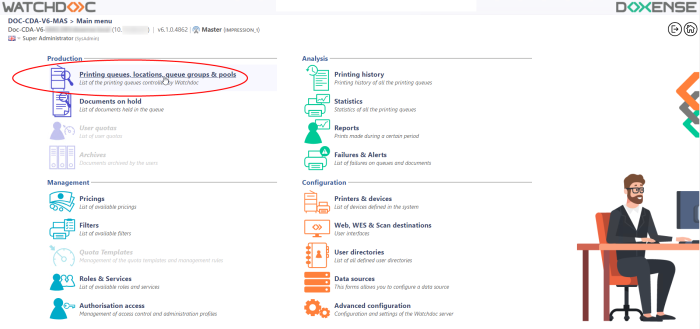Hewlett Packard WES - Configure the WES onto the queue
Access the interface
-
From the Main Menu of the Watchdoc administration interface, in the Production section, click Print Queues, Queue Groups & Pools:

è This takes you to the print queues interface. In this queue, activate the Controlled filter, then select the queue you want to configure:
-
For this queue, click the Edit Queue Properties button
 at the end of the line.
at the end of the line.
è You are taken to the Print Queue Properties interface in which several sections are displayed. WES properties are managed in the WES section.
Configure the print queue mode
In the Print Queue Properties interface, General Information section, select the operating mode for the queue:
-
Mode: select Validation to have users validate queued jobs so that they are actually printed. If the queue belongs to a group configured in Validation mode, you can also select Like Group.
Configure the WES onto the queue
In the Print Queue Properties interface, click on WES to access the dedicated section.
-
Activate embedded interface: tick the box to use a WES.
-
Profile subsection: From the list, select the WES to configure. The list comprises profiles created ahead of time in your instance of Watchdoc. If the desired profile is not found there, you will need to configure it (see Configure a WES article).
-
WES identifier subsection: Once you have ticked the box and selected the profile, the ID of the WES field will fill itself with “$AUTOSERIAL$”. Keep it that way so that the server will determine itself the serial number of the device and use it as the WES ID. You can also input directly the serial number of the device in this field.
-
Diagnosis subsection: It may be useful to activate WES trace logging, especially to diagnose an anomaly. Use this subsection to specify settings relating to WES trace log files:
-
WES specific logs: Tick the box if you would like to generate trace log files on communications between Watchdoc and the WES and to keep them on the server.
-
Log level:From the list, select the type of requests you wish to trace:
-
Auto: retains standard traces ;
-
Include binary content: retains detailed traces.
-
-
File locations: Use this field to enter the path to the folder where you wish to save the trace files. If no path is specified, then by default, Watchdoc saves the trace files to C:\Program Files\Doxense\Watchdoc\logs.
-
-
-
Wes Settings subsection: Use this section to configure the connection settings between the WES and Watchdoc in cases where the connection is a secure one, so that you can override the device username, password and the type of connection that is configured in the instance just for one queue:
-
TLS/SSL: Tick this box if the connection is secured using this protocol and fill-in the following fields:
-
Use the default credentials: Tick this box to use the identifiers already preset when the WES was configured.
-
Device Username: Use this field to enter the device administrator's account;
-
Device Password: Use this field to enter the password assigned to the device administrator;
-
Device can handle colour documents: Tick this box if the if the print device offers:

-
Configure the Spool transformation
The Spool transformation function lets Watchdoc impose or propose to users changes to the initial print criteria to better match the print policy implemented:
-
Enabled: Tick the box to enable the feature. Enable this feature enables Client Side Rendering mode in the Device section.
-
Disbabled: Tick the box to disable this feature
-
Use group value: Tick this box to use this feature as set in the print queues group.
-
Diagnostics: Watchdoc enables spool logs, especially to analyse the printing activity;
-
Enable spool logs: tick the box if you want that the spools may be save and set the tracing conditions;
-
Level: in the list, select the traces that you want to save (none, errors, edited spools and all);
-
Enable for: in the list, select how long you want to enable spool tracing (an hour, a day, a week or a month).

-
Validate the configuration
1. Click on  to validate the WES configuration on the print queue.
to validate the WES configuration on the print queue.
2. After having configured the WES onto the queue, you must install it.
N.B.: After modifying a WES profile already installed on a print queue, it is necessary to restart the queue so that it takes account of the profile modifications. To restart a queue, click on the "pause" and then "start" buttons in the queue list.
